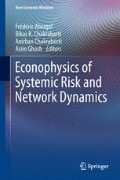Abstract
We investigate into the rank-size distributions of urban agglomerations for India between 1981 to 2011. The incidence of a power law tail is prominent. A relevant question persists regarding the evolution of the power tail coefficient. We have developed a methodology to meaningfully track the power law coefficient over time, when a country experience population growth. A relevant dynamic law, Gibrat’s law, is empirically tested in this connection. We argue that these empirical findings for India are in contrast with the findings in case of China, another country with population growth but monolithic political system.
Access this chapter
Tax calculation will be finalised at checkout
Purchases are for personal use only
References
Zipf GK (1949) Human behaviour and the principle of least effort. Addison-Wesley, Cambridge
Zipf GK (1935) The psychobiology of language. Houghton-Mifflin, Boston
Sasaki Y et al. (2006) J Phys Soc Jpn 75:074804
Huberman BA et al. (1998) Science 280:95
Yakovenko VM, Rosser JB Jr (2009) Rev Mod Phys 81:1703
Chatterjee A, Chakrabarti BK (2007) Eur Phys J B 60:135
Baldwin RB (1964) Astron J 69:377
Malamud BD et al. (1998) Science 281:1840
Boffetra G et al. (1999) Phys Rev Lett 83:4662
Malacarne LC, Mendes RS (2000) Physica A 286:391
Blasuis B, Tonjes R (2009) Phys Rev Lett 103:218701
Zanette D, Manrubia SC (1997) Phys Rev Lett 79:523
Moura NJ Jr, Ribeiro MB (2006) Physica A 367:441
Gabaix X, Ioannides Y (2004) Handbook of regional and urban economics 4. Enderson V, Thisseb J-F (eds) North-Holland, Amsterdam, p 2341
Krugman P (1996) The self organising economy. Blackbell Publishers, Oxford, UK and Cambridge
Gabaix X (1999) Q J Econ 114:739
Soo KT (2005) Reg Sci Urban Econ 35(3):239
Kuninaka H, Matsushita M (2008) J Phys Soc Jpn 77:114801
Eeckhout J (2004) Am Econ Rev 94(5):1429
Gangopadhyay K, Basu B (2010) Econophysics and economics of games, social choices and quantitative techniques. ISBN: 978-88-470-1500-5, p 90
Clauset A, Shalizi CR, Newman MJ (2009) SIAM Rev 51:661
Gangopadhyay K, Basu B (2009) Physica A 388:2682
Pagan A, Ullah A (1999) Nonparametric econometrics. Cambridge University Press, Cambridge
Chen Z, Fu S, Zhang D (2010) Searching for the parallel growth of cities. SSRN Working Paper
Nema P, Pokhariyal P (October 5, 2008) SEZs as growth engines – India vs China. SSRN Working Paper
Sen A (Nov 2006) Will India recreate China’s SEZ magic? The Economic Times
Author information
Authors and Affiliations
Corresponding author
Editor information
Editors and Affiliations
Rights and permissions
Copyright information
© 2013 Springer-Verlag Italia
About this chapter
Cite this chapter
Gangopadhyay, K., Basu, B. (2013). Evolution of Zipf’s Law for Indian Urban Agglomerations Vis-à-Vis Chinese Urban Agglomerations. In: Abergel, F., Chakrabarti, B., Chakraborti, A., Ghosh, A. (eds) Econophysics of Systemic Risk and Network Dynamics. New Economic Windows. Springer, Milano. https://doi.org/10.1007/978-88-470-2553-0_8
Download citation
DOI: https://doi.org/10.1007/978-88-470-2553-0_8
Publisher Name: Springer, Milano
Print ISBN: 978-88-470-2552-3
Online ISBN: 978-88-470-2553-0
eBook Packages: Physics and AstronomyPhysics and Astronomy (R0)

